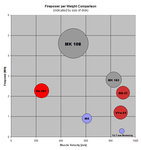Greetings ladies and gentlemen.
I think you could find this information useful, its in russian, but tables are easy to understand.
http://okirillov.tripod.com/data/rastr/Spravka.htm
Tables № 1 and 2 (табл. №1, табл. №2) show results of aircraft weapons testing which took place in 1947-1948 and 1950-1951. It was a ground testing against actual aircrafts. Сonditions and ranges was set according to «realistic combat conditions». Data in rows shows average number of hits needed to put aircraft out of action.
Some acronyms and translations:
ФЗТ – High Explosive Incendiary Tracer, ФЗ - High Explosive Incendiary, ОЗТ - Fragmentation Incendiary Tracer, ОФТ - Fragmentation Tracer, Ф/ФУГ - High Explosive, МДЗ – Instant Action Incendiary, БЗ – Armor Piercing Incendiary, БЗТ - Armor Piercing Incendiary Tracer, Б-32 – B-32 (12.7mm Armor Piercing Incendiary Bullet)
Б – Boeing, Ту – Tupolev, Пе - Petlyakov, Ла - Lavochkin, Як - Yakovlev, Ил - Ilyushin, МиГ - Mikoyan-Gurevich.
Сзади – from the rear, Спереди – from the front, без учета крыльев – wings don't take into account
А-23, А-44, А-67 – fuse mark. A-23 – probably delayed action, A-67 (aka Б-23) - instant action
Guns:
Н-57 – experimental 57mm cal cannon, НС-37 - NS-37, М-4 - 37mm M4, НР-23 - NR-23, НС-23 – NS-23 (same ammo as NR-23), Г-20 - experimental 20mm cal cannon, Испано – Hispano, МГ-151 - MG 151/20, УБ-12,7 - 12.7mm UB, Оп. 30 мм - experimental 30mm cal cannon, Ш-3 - experimental 23mm cal cannon
http://www.quarry.nildram.co.uk/WW2guneffect.htm
http://www.quarry.nildram.co.uk/modern_fighter_gun_effectiveness.htm
I think you could find this information useful, its in russian, but tables are easy to understand.
http://okirillov.tripod.com/data/rastr/Spravka.htm
Tables № 1 and 2 (табл. №1, табл. №2) show results of aircraft weapons testing which took place in 1947-1948 and 1950-1951. It was a ground testing against actual aircrafts. Сonditions and ranges was set according to «realistic combat conditions». Data in rows shows average number of hits needed to put aircraft out of action.
Some acronyms and translations:
ФЗТ – High Explosive Incendiary Tracer, ФЗ - High Explosive Incendiary, ОЗТ - Fragmentation Incendiary Tracer, ОФТ - Fragmentation Tracer, Ф/ФУГ - High Explosive, МДЗ – Instant Action Incendiary, БЗ – Armor Piercing Incendiary, БЗТ - Armor Piercing Incendiary Tracer, Б-32 – B-32 (12.7mm Armor Piercing Incendiary Bullet)
Б – Boeing, Ту – Tupolev, Пе - Petlyakov, Ла - Lavochkin, Як - Yakovlev, Ил - Ilyushin, МиГ - Mikoyan-Gurevich.
Сзади – from the rear, Спереди – from the front, без учета крыльев – wings don't take into account
А-23, А-44, А-67 – fuse mark. A-23 – probably delayed action, A-67 (aka Б-23) - instant action
Guns:
Н-57 – experimental 57mm cal cannon, НС-37 - NS-37, М-4 - 37mm M4, НР-23 - NR-23, НС-23 – NS-23 (same ammo as NR-23), Г-20 - experimental 20mm cal cannon, Испано – Hispano, МГ-151 - MG 151/20, УБ-12,7 - 12.7mm UB, Оп. 30 мм - experimental 30mm cal cannon, Ш-3 - experimental 23mm cal cannon
http://www.quarry.nildram.co.uk/WW2guneffect.htm
http://www.quarry.nildram.co.uk/modern_fighter_gun_effectiveness.htm


 3 Sprgr.L.
3 Sprgr.L.